Manual transmission driving schools offer hands-on training to master clutch control‚ gear shifting‚ and smooth coordination. They provide structured lessons and expert instructors to help learners become proficient in driving stick-shift vehicles‚ ensuring safety and confidence on the road.
What Are Manual Transmission Driving Schools?
Manual transmission driving schools specialize in teaching individuals how to operate vehicles with manual transmissions. These schools provide hands-on training focused on mastering clutch control‚ smooth gear shifting‚ and coordination. They often offer structured lessons tailored to learners’ skill levels‚ from beginners to those needing refresher courses. Instructors at these schools are typically experienced in teaching manual driving techniques‚ ensuring students gain confidence and proficiency. Many schools also provide access to stick-shift cars for practice‚ making the learning process practical and effective. Examples include Stick Shift Lessons and Primo Driving School‚ known for their expertise in manual transmission training.
Why Learn to Drive a Manual Transmission?
Learning to drive a manual transmission offers better control over the vehicle‚ improved fuel efficiency‚ and cost-effectiveness. It enhances driving skills and connection to the road‚ making the experience more engaging. Mastering a manual transmission also opens up more car options and can be a valuable skill for emergencies or driving different vehicles. Additionally‚ it reduces reliance on automatic systems‚ fostering a deeper understanding of driving mechanics. Many drivers find it more enjoyable and rewarding‚ as it requires active participation and coordination between clutch‚ gears‚ and accelerator.
Benefits of Enrolling in a Manual Transmission Driving School
Enrolling in a manual transmission driving school provides structured‚ personalized training tailored to your learning pace. Expert instructors offer real-time feedback‚ helping you master clutch control‚ gear shifting‚ and smooth acceleration. These schools often use specially equipped vehicles designed for learning‚ reducing the risk of stalling or damage. Additionally‚ they cover essential driving scenarios like uphill starts and city traffic‚ building confidence in various conditions. Many schools also include refresher courses for experienced drivers‚ ensuring skills remain sharp. The focused environment accelerates the learning process‚ making you a proficient manual driver faster than self-teaching.

How to Find a Reputable Manual Transmission Driving School
Research online reviews and ratings to identify top-rated manual driving schools. Check credentials and certifications‚ ensuring instructors are experienced in teaching manual transmission skills effectively.
Research and Reviews: Top-Rated Manual Driving Schools
Researching top-rated manual driving schools involves checking online reviews‚ ratings‚ and testimonials. Platforms like Yelp highlight schools such as Stick Shift Lessons and Primo Driving School‚ praised for their expert instructors and structured programs. Reading reviews helps identify schools with experienced teachers who specialize in manual transmission training. Many reviewers emphasize the importance of hands-on practice and patient instructors. Additionally‚ websites like Driving-School-Beckenham offer guides and videos to complement lessons. By comparing reviews‚ learners can find reputable schools that cater to their needs and skill levels‚ ensuring a smooth learning experience.
Key Factors to Consider When Choosing a Driving School
When selecting a manual transmission driving school‚ prioritize instructors with extensive experience in teaching manual driving. Ensure the curriculum is tailored to manual transmission skills‚ including clutch control and gear shifting. Look for schools that provide modern‚ well-maintained vehicles for practice. Class size and instructor-to-student ratio are crucial for personalized attention. Check if the school offers flexible scheduling to accommodate your needs. Transparency in pricing and package deals is also important. Finally‚ verify the school’s reputation through reviews and ask about their success rate with manual transmission learners to ensure you’re making an informed decision.
How to Check Credentials and Certifications
To ensure a driving school is reputable‚ verify its credentials and certifications. Look for accreditation from recognized organizations‚ such as state licensing boards or professional driving associations. Check if instructors hold certifications like Certified Driving Instructor (CDI) or similar qualifications. Visit the school’s website to confirm displayed certifications and contact certifying bodies to verify their legitimacy. Also‚ review state-specific databases to ensure the school is licensed to operate. Finally‚ inquire about instructor experience and success rates to ensure you’re receiving high-quality training tailored to manual transmission driving.

The Learning Process at Manual Transmission Driving Schools
The learning process combines structured programs with hands-on practice. Students master clutch control‚ gear shifting‚ and theoretical knowledge‚ progressing to real-world scenarios under instructor guidance.
Step-by-Step Guide to Learning Manual Transmission
Learning manual transmission involves a structured approach. Start with understanding the clutch and accelerator relationship. Practice pressing the clutch fully and shifting gears smoothly. Begin in a flat‚ open area to master basic control. Gradually progress to uphill and downhill driving to enhance skill. Focus on coordination between clutch release and acceleration. Instructors provide feedback to refine techniques. Regular practice helps build muscle memory and confidence. Advanced lessons cover city driving‚ merging onto highways‚ and handling emergencies. Consistent practice ensures proficiency in operating a manual vehicle safely and efficiently in various driving conditions.
Practice Areas and Techniques for Mastering Manual
Effective practice for manual transmission requires diverse environments. Begin in an empty parking lot to master clutch control and smooth shifting. Gradually move to quiet streets to practice acceleration and braking. Instructors often recommend practicing uphill and downhill to refine gear selection and control. Consistent practice in varying conditions builds confidence and reflexes. Techniques include focusing on clutch feathering‚ seamless gear transitions‚ and coordinating throttle input. Regular drills‚ such as reversing and tight turns‚ enhance precision. Practicing in first and reverse gears improves familiarity with the vehicle’s response. Dedication to these techniques ensures mastery of manual driving in real-world scenarios.
Common Challenges Faced by Learners
Learners often struggle with clutch control‚ leading to frequent stalling. Smooth gear transitions and coordination between the clutch and accelerator are difficult to master initially. Stalling‚ especially on inclines‚ can be frustrating. Many find it challenging to shift gears at the right RPM‚ causing jerky movements. Additionally‚ reversing and parking in tight spaces with a manual transmission can be daunting. Beginners may also hesitate when shifting gears‚ causing delays in reaction time. Overcoming these challenges requires patience‚ consistent practice‚ and a focus on developing muscle memory. Instructors play a crucial role in guiding learners through these obstacles to build confidence and competence.
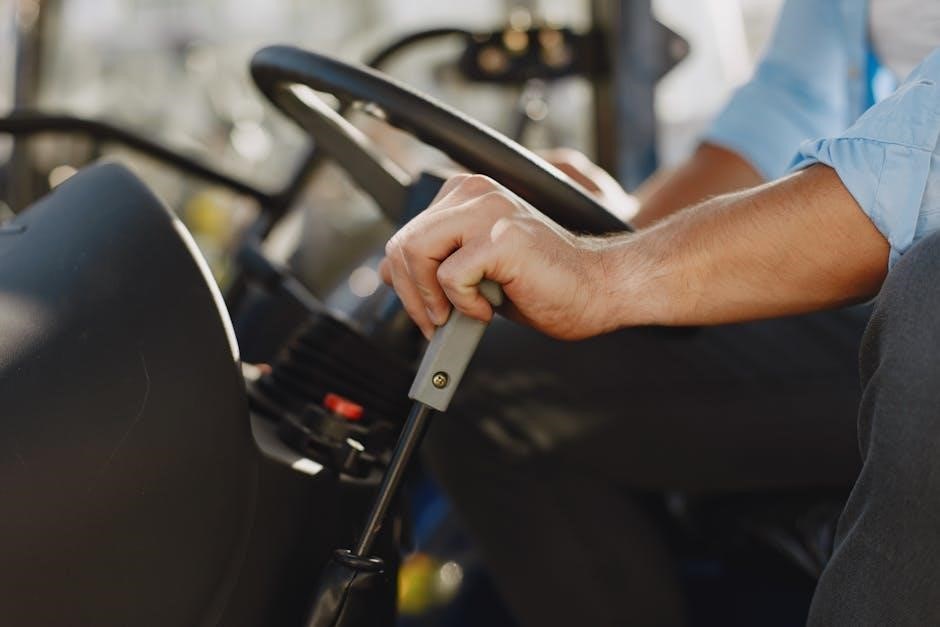
Cost and Scheduling of Manual Transmission Lessons
Manual transmission lessons typically cost $50-$100 per session‚ depending on location and instructor experience. Scheduling offers flexibility‚ including weekends‚ to accommodate learners’ needs and preferences.
Average Cost of Manual Transmission Driving Lessons
The average cost of manual transmission driving lessons ranges from $50 to $90 per session‚ depending on location and instructor expertise. Urban areas tend to have higher rates‚ while rural regions may offer lower pricing. Many schools provide package deals‚ reducing the per-lesson cost when booking multiple sessions. Total costs vary based on individual progress‚ with some learners mastering skills in 5-10 lessons‚ while others may need more. It’s essential to inquire about pricing structures and any available discounts when selecting a driving school for manual transmission training.
Factors That Influence Pricing
Pricing for manual transmission driving lessons varies based on several factors. Location plays a significant role‚ with urban areas typically costing more than rural regions. Instructor experience and qualifications also impact rates‚ as more skilled teachers may charge higher fees. The number of lessons required‚ determined by the learner’s skill level and progress‚ affects total cost. Additionally‚ the reputation and credentials of the driving school‚ as well as the type of vehicle used for training‚ can influence pricing. Some schools offer package deals or discounts‚ which can reduce the overall expense for learners.
How to Schedule Lessons and Plan Your Time
Scheduling manual transmission lessons requires balancing flexibility and consistency. Many driving schools offer flexible hours‚ including weekends and evenings‚ to accommodate learners’ schedules. It’s important to commit to regular lessons to build momentum and retain skills. Consider how frequently you can practice—weekly or biweekly lessons are common. Each session typically lasts 60–90 minutes to maintain focus without causing fatigue. Plan your time by setting clear goals for each lesson‚ such as mastering clutch control or gear shifting. Communicate with your instructor to adjust the schedule as needed and ensure steady progress toward becoming a confident manual driver.

Refresher Courses for Manual Transmission Drivers
Refresher courses are ideal for drivers needing to regain confidence or improve rusty skills. They offer tailored lessons to enhance smooth shifting‚ clutch control‚ and overall mastery of manual driving techniques.
Who Can Benefit from Refresher Lessons?
Refresher lessons are perfect for drivers who haven’t driven a manual car in years‚ helping them regain confidence and sharpness. New owners of manual vehicles can also benefit‚ especially if they’re unfamiliar with their car’s specifics. Those moving to areas where manual transmissions are common will find these lessons invaluable. Additionally‚ anxious or less confident drivers can overcome fears like stalling or driving uphill. Even experienced drivers can refine their skills. These lessons cater to anyone seeking to improve their manual driving abilities‚ ensuring safer and more enjoyable driving experiences.
What to Expect from a Refresher Course
A refresher course for manual transmission driving focuses on rebuilding and refining skills. Expect a personalized assessment to identify areas needing improvement. Instructors will review clutch control‚ smooth gear transitions‚ and braking techniques. Practice sessions will cover various driving scenarios‚ such as uphill climbs‚ downhill descents‚ and city traffic. Feedback is provided to address bad habits and enhance confidence. The course also includes tips for vehicle maintenance and troubleshooting common issues. By the end‚ drivers will feel more comfortable and in control behind the wheel‚ ready to tackle challenging situations with ease and precision.
Improving Confidence and Skills
Refresher courses at manual transmission driving schools are designed to boost confidence and refine skills. Instructors focus on addressing weaknesses and reinforcing proper techniques. Drivers learn to master clutch control‚ smooth gear transitions‚ and confident braking. Practice sessions include navigating challenging scenarios like steep hills and heavy traffic. Feedback is tailored to help drivers overcome specific struggles‚ such as stalling or hesitant shifting. Over time‚ learners develop muscle memory and a more intuitive connection with the vehicle. This renewed mastery leads to improved road safety and a more enjoyable driving experience‚ making even the most nervous drivers feel capable and assured behind the wheel.
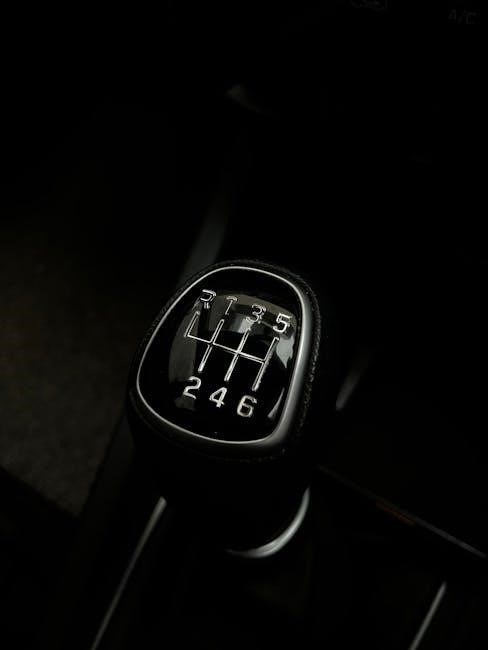
Practicing Outside of Driving School
Practicing manual transmission outside school helps reinforce skills. Find a safe‚ open space to hone clutch control and smooth shifting. Regular practice builds confidence and mastery.
Tips for Practicing Manual Transmission on Your Own
- Start in an empty parking lot to practice clutch control and shifting without traffic stress.
- Focus on slow-speed maneuvers‚ such as stopping and starting on inclines‚ to master balance.
- Use “feathering” the clutch to smooth transitions between gears during acceleration.
- Record your practice sessions to review and improve techniques.
- Practice in varying conditions‚ like hills or light traffic‚ to build adaptability.
- Gradually increase difficulty by tackling more challenging routes.
- Schedule regular practice sessions to reinforce muscle memory.
Safe and Effective Practice Techniques
To practice manual transmission safely and effectively‚ begin by finding a flat‚ open space like an empty parking lot. Always check your surroundings before starting. Use your mirrors and look over your shoulder to stay aware of your environment. Start with slow‚ deliberate movements‚ focusing on smooth clutch engagement and gear shifts. Avoid sudden accelerations or hard braking. Practice stopping on inclines to improve balance and control. Keep both hands on the wheel except for shifting gears. Stay relaxed and patient‚ as tension can hinder progress. Always prioritize safety and gradual improvement.
Understanding Your Vehicle’s Specific Features
Understanding your vehicle’s unique features is crucial for mastering manual transmission driving. Familiarize yourself with the clutch’s bite point and gear ratios‚ as these vary by car. Learn how to use the handbrake effectively‚ especially on inclines. If your car has features like rev-matching or hill-start assist‚ practice using them to enhance control. Adjust your driving technique based on your car’s power delivery and weight distribution. Knowing your vehicle’s characteristics ensures smoother shifts‚ better acceleration‚ and safer braking. This tailored approach helps you become a more confident and capable manual driver. Always consult your car’s manual for specific details.
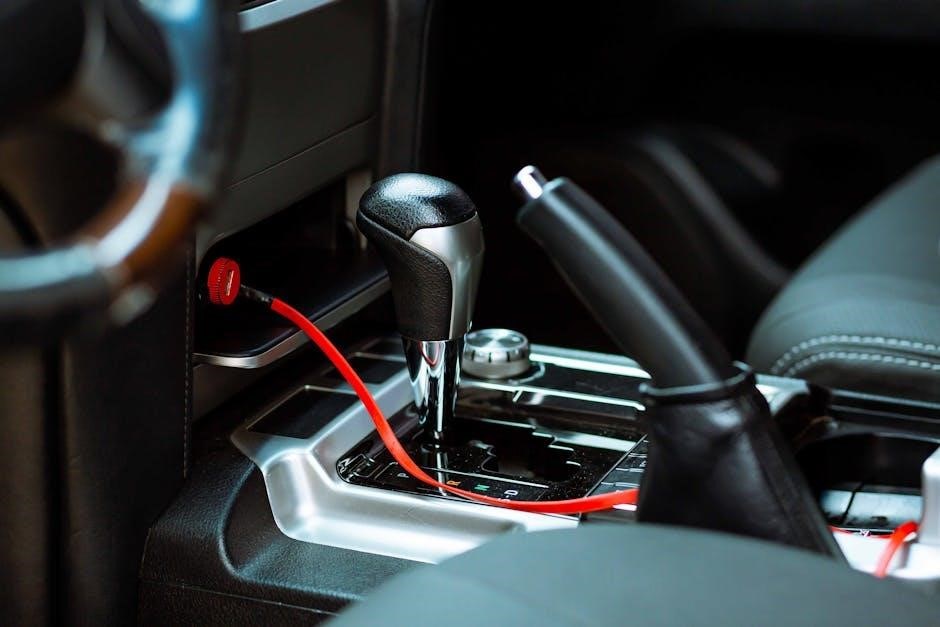
Overcoming Common Challenges
Mastering manual transmission requires addressing common hurdles like stalling‚ smooth shifting‚ and hill starts; Consistent practice builds muscle memory and coordination‚ ensuring progress and confidence.
Mastering Clutch Control and Gear Shifting
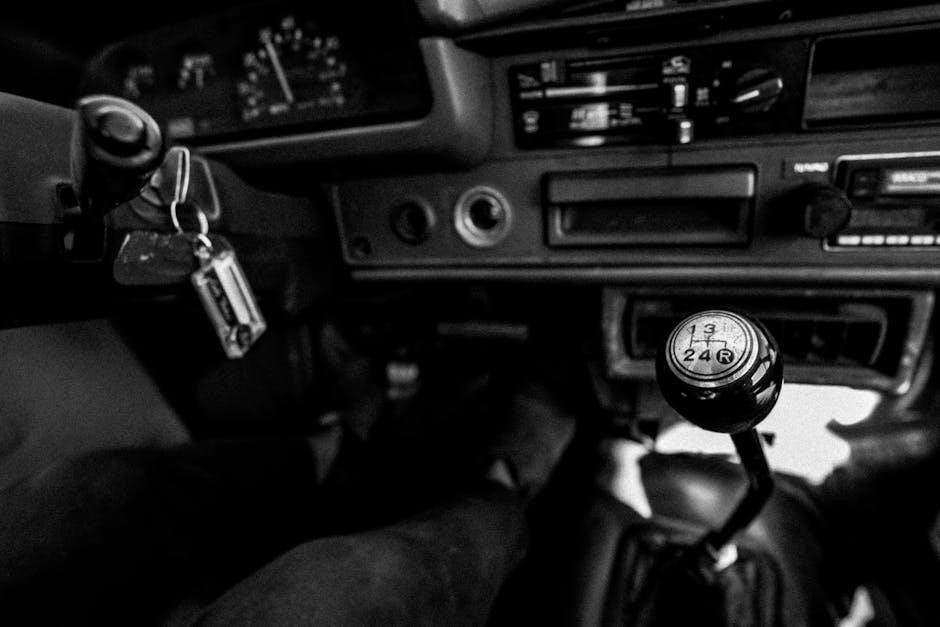
Clutch control and gear shifting are foundational skills for manual transmission drivers. Proper coordination between the clutch pedal and accelerator ensures smooth transitions. Start with slow‚ deliberate movements‚ gradually increasing speed as confidence grows. Practice shifting gears at the correct RPM to avoid jerking or stalling. Listening to engine sounds helps gauge when to shift. Instructors emphasize the importance of feathering the clutch for seamless acceleration. Regular practice in a safe‚ flat area builds muscle memory and improves coordination. Over time‚ these actions become second nature‚ enhancing overall control and driving efficiency.
How to Avoid Stalling the Car
Stalling is common when learning manual transmission‚ but it can be minimized with practice. Start by ensuring the car is in first gear and the parking brake is disengaged. Gradually release the clutch pedal while pressing the accelerator gently. Avoid sudden movements‚ as this can cause the engine to stall. If the car begins to jerk‚ ease off the accelerator and slowly release the clutch again. On inclines‚ use the parking brake to prevent rolling. Smooth coordination between the clutch and accelerator is key. With consistent practice‚ stalling becomes less frequent‚ and confidence behind the wheel grows.
Driving Uphill and Downhill in a Manual Car
Mastering uphill and downhill driving in a manual car requires precise gear control and clutch management; When driving uphill‚ use lower gears to maintain traction and avoid rolling backward. Downshift before descending to control speed without riding the brakes. On steep inclines‚ feather the clutch and accelerator to creep forward smoothly. For downhill driving‚ stay in a lower gear to regulate speed and reduce brake wear. Always reduce speed before approaching hills and use proper gear selection to maintain control. Practice these techniques in safe environments to build confidence and proficiency in varying terrain.
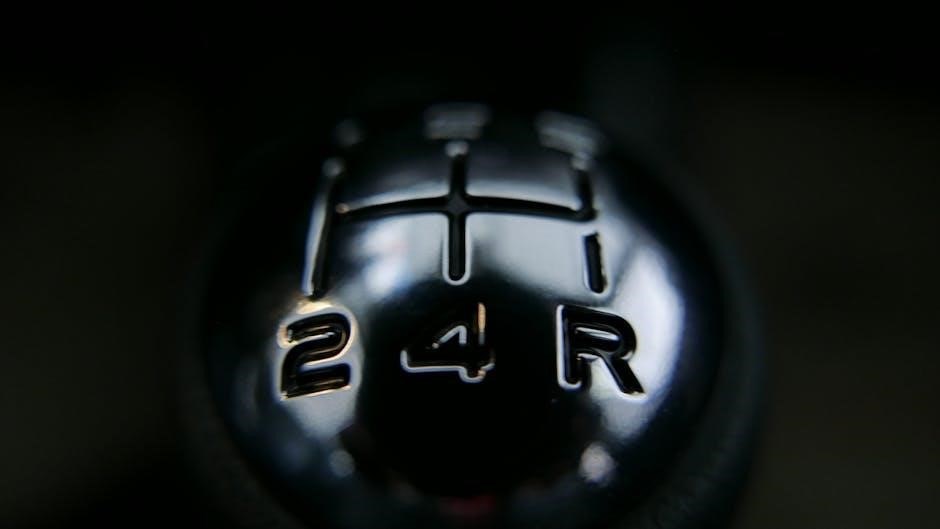
The Role of Instructors in Manual Transmission Training
Instructors provide personalized feedback‚ hands-on training‚ and guidance to help learners master manual driving skills‚ building confidence and competence behind the wheel effectively.
Qualifications and Experience of Instructors
Instructors at manual transmission driving schools are typically certified professionals with extensive experience in teaching manual driving techniques. Many have years of hands-on experience and specialized training in transmission mechanics. They often hold certifications from recognized driving education organizations and may have backgrounds in automotive education or racing. Experienced instructors can tailor lessons to individual learning styles‚ ensuring mastery of clutch control‚ gear shifting‚ and smooth acceleration. Their expertise helps students overcome common challenges‚ such as stalling or inconsistent shifting. With patient guidance‚ instructors create a supportive environment for learners to build confidence and proficiency in manual driving.
How Instructors Teach Manual Transmission Skills
Instructors at manual transmission driving schools use a structured approach to teach essential skills. They begin with demonstrations of clutch control‚ gear shifting‚ and acceleration‚ followed by hands-on practice in controlled environments. Lessons are broken into manageable steps‚ focusing on coordination and smooth transitions. Instructors emphasize the feel of the clutch and proper shifting techniques. They also simulate real-world scenarios‚ such as uphill driving or stopping and starting on inclines‚ to build practical proficiency. Through patient guidance‚ instructors help students develop muscle memory and confidence‚ ensuring they master the fundamentals of manual driving effectively.
Communication and Feedback During Lessons
Effective communication and feedback are crucial in manual transmission driving lessons. Instructors provide clear‚ step-by-step instructions‚ ensuring students understand proper techniques. They offer positive reinforcement to build confidence and constructive criticism to address mistakes. Real-time feedback helps learners improve clutch control‚ gear shifting‚ and acceleration. Instructors also adapt their teaching style to suit individual learning paces‚ ensuring personalized attention. Regular progress updates and goal-setting help students stay motivated and focused. Open communication fosters a supportive learning environment‚ enabling students to master manual driving skills efficiently and confidently. This collaborative approach ensures a successful learning experience.
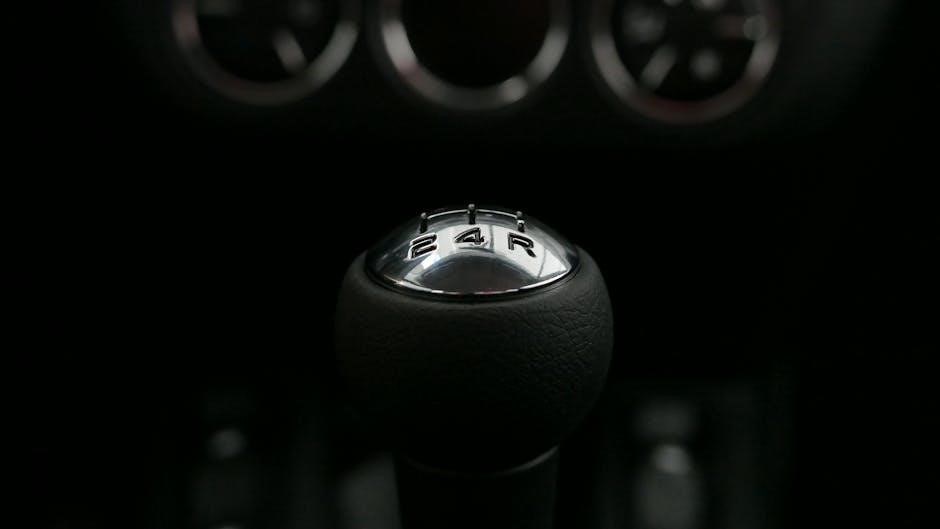
After Completing the Driving Course
After completing a manual transmission driving course‚ you’ll gain the skills to operate a manual car confidently. Next steps include obtaining your driver’s license‚ building experience‚ and maintaining safe driving practices.
Obtaining a Driver’s License for Manual Transmission
After completing your manual transmission driving course‚ you’ll need to obtain a driver’s license that reflects your ability to drive a manual car. Most states require a driving test specifically for manual transmission vehicles. This test assesses your clutch control‚ smooth gear shifting‚ and ability to handle various driving scenarios. Be prepared to demonstrate these skills confidently during the DMV test. Additionally‚ ensure your driving school provides documentation of your training‚ as some states may require proof of completion. Once licensed‚ you’ll have the freedom to drive any manual transmission vehicle with increased confidence and control.
Building Confidence as a Manual Driver
Building confidence as a manual driver is a gradual process that combines practice‚ patience‚ and positive reinforcement. Start with basic maneuvers‚ such as starting from a standstill and shifting gears smoothly‚ in a safe‚ controlled environment. As you master these skills‚ gradually introduce more complex scenarios‚ like driving uphill or in heavy traffic. Professional instructors can provide personalized feedback to help you improve. Celebrate small victories to stay motivated and remind yourself that consistency is key. Over time‚ you’ll develop muscle memory and a deeper connection with your vehicle‚ leading to increased confidence and enjoyment behind the wheel.
Insurance and Road Safety Considerations
Learning to drive a manual transmission can potentially lower your insurance rates‚ as insurers may view manual drivers as more attentive and skilled. Manual driving requires active engagement‚ reducing distractions and enhancing control over the vehicle. This can lead to safer driving practices‚ particularly in situations requiring quick acceleration or deceleration. Additionally‚ the ability to manage gears effectively in varying road conditions contributes to better overall control. While specific insurance benefits for manual transmission driving courses vary‚ the enhanced skills often result in safer driving habits‚ potentially leading to fewer accidents and lower premiums.
Mastering manual transmission driving through specialized schools equips learners with essential skills‚ enhancing control and confidence. These programs foster safer‚ more engaging driving experiences‚ empowering drivers with control and confidence for lifelong automotive mastery.
Final Thoughts on Manual Transmission Driving Schools
Manual transmission driving schools offer a structured path to mastering clutch and gear control‚ boosting confidence and driving precision. With experienced instructors guiding learners through tailored lessons‚ these programs ensure a strong foundation in manual driving. Beyond the technical skills‚ enrolling fosters a deeper connection with the vehicle‚ enhancing overall driving enjoyment. Graduates gain the ability to handle various cars confidently‚ making them versatile drivers. For those eager to refine their abilities or learn from scratch‚ these schools provide invaluable training‚ paving the way for a lifetime of safe and skillful driving experiences. Embrace the challenge and invest in your driving future today.
Encouragement to Enroll in a Manual Driving Course
Learning to drive a manual transmission car is a rewarding skill that enhances control and confidence behind the wheel. Enrolling in a manual driving course provides personalized instruction tailored to your needs‚ helping you master clutch control‚ smooth shifting‚ and real-world scenarios. With patient instructors and hands-on practice‚ you’ll gain the skills and confidence to drive any manual car with ease. Whether you’re a new driver or looking to improve‚ this course is a valuable investment in your driving future. Don’t miss the opportunity to master a skill that will last a lifetime—sign up today!